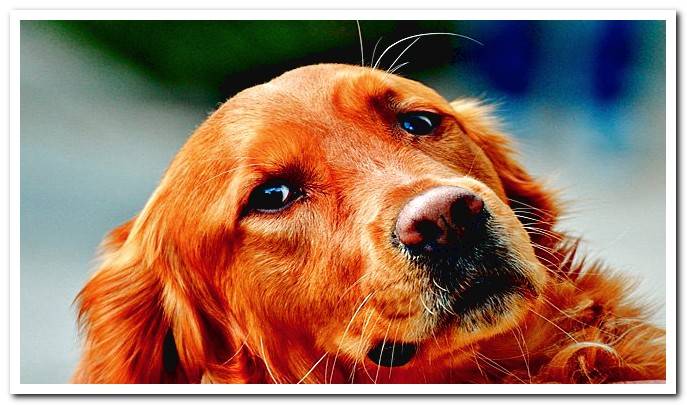
Known for his extraordinary qualities as a hunting dog, the Setter is also an excellent companion dog, capable of adapting to any family environment.
There are four types of Setter and each of them has unique characteristics. Do you want to know them? From Dogsis.com we tell you all its details.
Index of contents
- 1 Different types of Setter dog
- 2 The English Setter
- 2.1 How is it physically?
- 2.2 Breed morphology
- 2.3 Temperament of the English Setter
- 3 The Gordon Setter
- 3.1 Gordon Setter physical characteristics
- 3.2 Morphological features
- 3.3 Gordon Setter Behavior
- 4 The Red and White Irish Setter
- 4.1 How is it physically?
- 4.2 Morphology of the Irish Red and White Setter
- 4.3 Temperament of the English Red and White Setter
- 5 The Irish Setter
- 5.1 What is an Irish Setter like physically?
- 5.2 Irish Setter Dog Breed Morphology
- 5.3 General temperament and behavior
- 6 Possible diseases in Setter dogs
- 7 Food and care in all types of Setter
Different types of Setter dog
The Setter, despite being classified into different types, has some common features that identify them as such. Generally, all Setters have long fur on the ears, chest, legs and tail. Their weight ranges from 20 to 32 kg approximately and they measure around 58-69 cm.
Its origin dates back to the end of the Middle Ages in France. Although he is considered a descendant of Braco, there are those who affirm that he is a “Improved spaniel ” Many people resemble the Setter breed with the Pointer because of its great similarity since the main difference is the reduction in capillary volume in the latter.
This belief is erroneous since there is evidence that the Setter already existed before the Pointer in England therefore there would be no blood in common between both races.
The Setter is known for directing its use towards the search for parts in the open field, or what is the same, is the ideal hunting dog. It is included within a “type or sample dog”: hunting dogs.
This name refers to the instinct of the dog, which makes him point or show the direction where the hunting piece is with the muzzle, thus allowing the hunter to move in order to have the piece within range. Let’s see what are the different types of this breed:
- English setter
- Gordon Setter
- Irish Red and White Setter
- Irish setter
The English Setter
It is the best-known Setter type of the entire breed. Its breeding began in the 15th century when it was taken to Great Britain, coming from France, where there was a separation into different lines, which we will also talk about later.
The first club destined for this breed was founded in 1890, receiving the name of English Setter Club. Currently, two parallel lines have been configured to classify this breed: the first, larger dogs, with large fringes and suitable for beauty contests.
The other is about dogs of a smaller size, but with unbeatable capacities for work in the field.
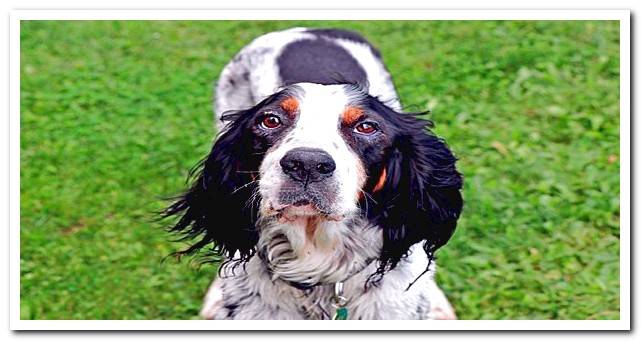
How is it physically?
Medium in size, with a defined silhouette and elegant appearance and movement, what attracts the most attention with the naked eye is its fur.
The English Setter is characterized by enjoying beautiful hair, normally speckled white in color, with black and white being typical and characteristic. It is possible to discover them in brown in their entirety and even white.
Visually it is a long, silky coat of hair with slight undulations (never curly) from the back of the head and long fringes that run through each of the four legs from the back of the thighs and the forelimbs until reaching almost at the foot.
As a curiosity, each hair color in the English Setter, due to its variations, receives a different and specific name. The word “will be usedBelton ”Because it alludes to a region of Northumberland.
This is what Setter’s fur spots are called. When the dog’s hair is black and white, they talk about fur Blue Belton. If the dog is white and orange it will be talked about Orange Belton. If the orange color has more or less intensity, this coat will be called Lemon Belton or Liver Belton.
It can happen that the three colors are united: white, black and orange. In this case we will talk about Tricolor. When the Setter presents mottled hair, depending on the distribution of its spots we will talk about Blue Belton almost black or almost white.
Breed morphology
Regarding size, considering that it is a medium breed, there is a difference between males and females. Males range from 65-69 cm and females between 61-65 cm. The English Setter is a dog that has an elegant and majestic bearing, although, at the same time, it is strong and resistant.
It has a long muscular neck that continues towards a wide and proportional chest. With a short back and bulging ribs, the kidney area is slightly arched with a slightly flexed hip.
As for its extremities, it is worth noting the lower ones because it has especially long thighs that are distributed from the hip to its hamstrings.
Its eyes are large, bright and expressive, with a sweet look and a dark or hazel color. The ears, which hang down the length of the cheeks, are low and long. Its tail is of medium length and with a very smooth curvature.
When on the move, the English Setter exhibits free and graceful movement characterized by speed and endurance. Elegant and fast, but never brash.
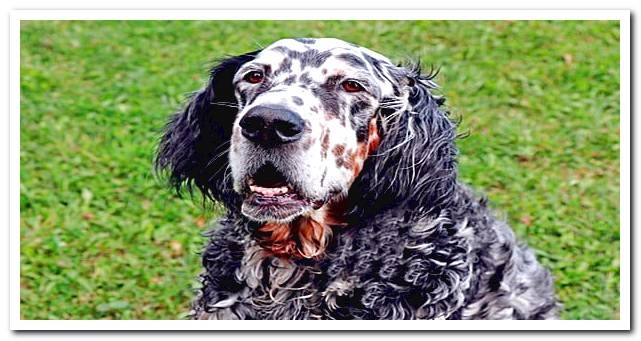
Temperament of the English Setter
The English Setter is known for his friendly and personable character. It is a very active dog with a keen sense for hunting. This is why it offers grea
t resistance covering a large amount of terrain including the water plane.
At the same time, we find ourselves before a calm, faithful, obedient and friendly dog, although sometimes it can be a bit stubborn since it is difficult to train.
The ideal is to start training from a puppy, from three to four months of age, to avoid tending towards independence. Despite this, he has great fidelity to his master, making him a perfect companion. He is smart and especially respects children and the elderly.
Its sense of smell is exquisite, capable of detecting the trail of a prey even hours after it has left the place. When it chases a piece, it does so slowly, silently and in perfect harmony with the environment, so it goes unnoticed by the prey.
Its use is very common among hunting all kinds of birds such as partridge, quail and woodcock, as well as hunting waterfowl.
It’s a dog very curious and affectionate. Because you need a lot of space to exercise due to your restlessness, it is not ideal for people who live in very small spaces with little physical activity.
It has a very balanced character, adapting to any situation. It is recommended for those people who like an especially sociable dog, so if you are looking for a home protector, this not your suitable race.
The Gordon Setter
The Gordon Setter is a type of Setter characterized by being a light dog whose coat of hair is wavy in color black and with brown or tan spots. It is the least widespread of the entire Setter race. It originated in Scotland during the 17th century.
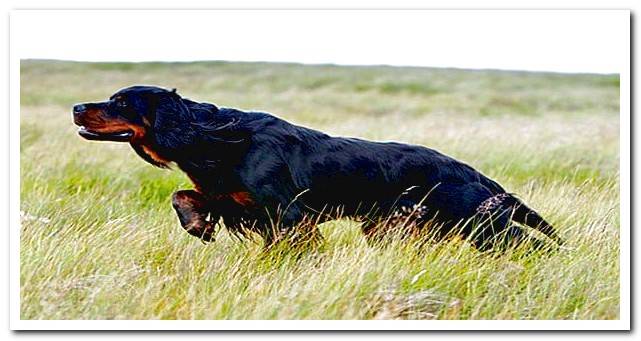
Gordon Setter physical characteristics
Despite the fact that, physically, all the Setter are very similar, there are some differences.
Its hair is very similar to the hair of the English Setter. Its color will always be darker, oscillating between bright and intense black and reddish brown by way of “fire marks ”(This is what the two spots above the eyes are called, on each side of the muzzle).
It usually has two large spots on the sill with a small white spot. The hair is short and fine on the head, as well as on the front of the limbs. In the rest of the body, the hair will be of a medium length ending in fringes towards the back of the limbs. A fringe between the belly and the chest is characteristic.
Morphological features
The Gordon Setter is medium length. Males have a measurement between 59-62 cm and females range between 56-62cm. It is a tall and robust dog.
Like the other types of the Setter breed, it has a well-lowered chest with very arched ribs and a short back. It is wide back with a slight curvature. Its neck is rather long, its limbs long and its tail is thick at birth, but thinner towards the end.
Its ears, characteristic of the breed, are low set and medium in size, thin and with a drop attached to the head line. He has beautiful bright dark brown eyes.
It is an elegant walking dog, with great agility and capable of achieving great speed. Its appearance and constitution is very harmonious and symmetrical.
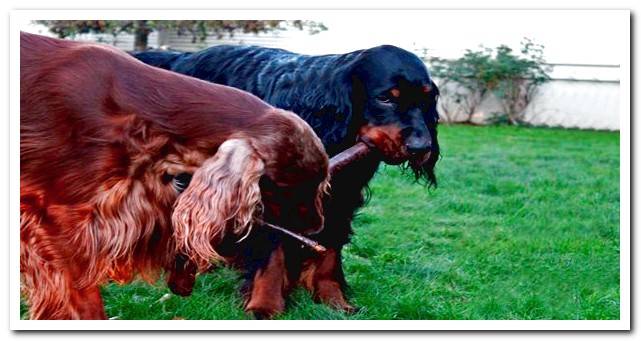
Gordon Setter Behavior
We are facing an intelligent dog, very calm, docile and affectionate, so it is an ideal and pleasant companion. Although it is true, it is a stubborn breed (like the Setter in general) so it needs a firm education, but with patience and affection.
Despite the fact that the Setter are characterized as hunting dogs, their methodical search is less extensive than that of the others, however, they are an extraordinary swimmer.
It does not have difficulties to adapt well to life in the city, although it is essential that you do a lot of physical exercise and live in fairly wide spaces.
The Red and White Irish Setter
It is the original Irish setter. Despite growing up since the 17th century, today it is very rare to find them since the red Irish Setter type predominates.
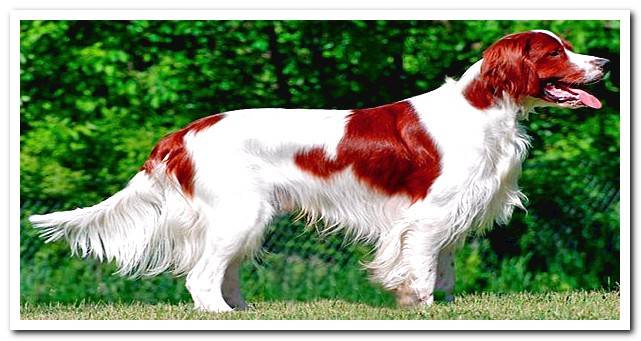
How is it physically?
Like the Irish or Red Setter, this breed has wavy hair with a silky smooth feel. We can also observe in this variant, the fringes on both front and rear legs how striking they make this dog, which are straight and smooth, being able to find some soft wave.
As its name suggests, the coat of this Setter stands out for having a white base color and having the body covered with uniform red marches / spots in the shape of an island.
Their hair could be categorized as medium length, and although their hair is medium in most of the body, they tend to have a certain composition of short and fine hair on the head, front of the legs and the tip of the ears.
It is a breed that requires a continuous care of the hair, to avoid a continuous change of hair, being frequent that the owners of the same ones argue that the dog “loose many hairs ”.
Morphology of the Irish Red and White Setter
This breed stands out for being a breed in which dogs are strong, athletic and generally of large build. With a net and square muzzle, we find a dog that has ears at eye level, fully attached to the head and generally falling back.
And, unlike the Irish Red Setter, it does not have such a strong occipital protuberance.
It has a medium / moderate length tail that tapers from the base to the tip, where it has the fringes so characteristic of the entire Setter breed.
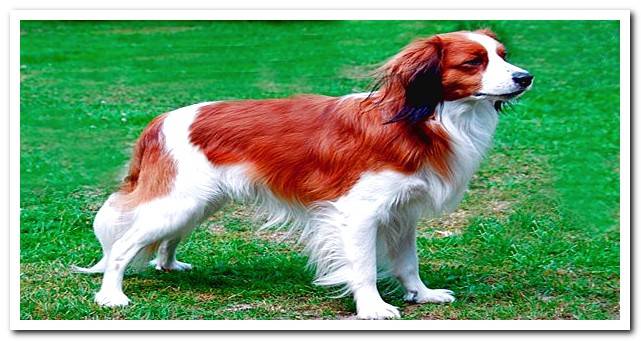
Temperament of the English Red and White Setter
It is a very intelligent, smart and sweet dog. It’s a breed perfect for homes in which there are children or other animals, since it is generally calm and tends to socialize easily. They can become very unruly, which is corrected by correct parenting and learning in their puppy days.
Although he is an impulsive dog at times, he loves to please the owners or people with whom he surrounds himself. It is not usually very introverted with those who are not familiar and is a perfect dog for environments where there are always people. They take loneliness very badly, getting nervous and even with a certain aggressive component.
He requires high physical activity, so the perfect thing for him would be to live in a rural area or where he has a space outside to go out and enjoy.
The Irish Setter
The Irish Setter is a variety of Setter that began to breed in Ireland during the 18th century. Its long, fiery reddish-brown hair is very characteristic.
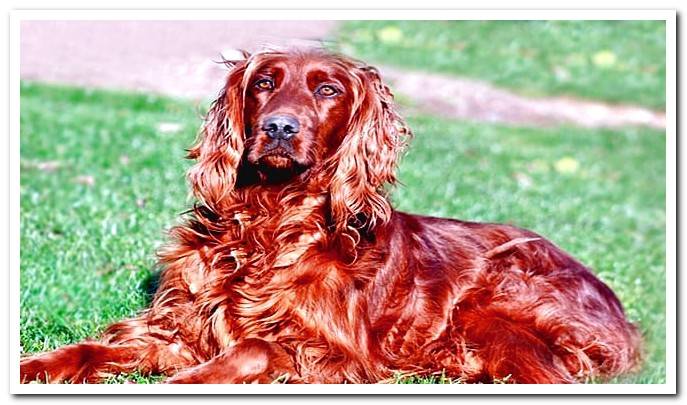
What is an Irish Setter like physically?
Generally, this breed is characterized by showing a thick and smooth coat. It is usually of medium length and flat in most of the body, although in areas such as the head, front legs and tip of the ears, it tends to be much shorter and thinner.
The color of the hair of this breed is usually a limited spectrum, finding us varieties that range from the ranges of the reddish chestnut trees, coming to find us exemplary around the mahogany reds.
Hence this breed is known as the Irish Setter or Red Setter. In addition, it usually has a fairly thick coat (even on the tail) and for being of a silky touch on the entire body
Regarding grooming and cleaning, we are dealing with a breed of dog that requires medium / moderate care.
Irish Setter Dog Breed Morphology
The Irish setter stands out for being a portentous, large and stylized dog. With an elongated, thin and fine head and an oval-shaped skull. Also, one of its most prominent features of the head is the muzzle.
In terms of colors, the nose of these dogs is usually black or even mahogany (like the fur on many occasions) and as for the eyes, which do not usually stand out for their large size, they are usually dark brown or hazelnut.
In relation to the ears, we can say that they tend to fall backwards and be as silky as the rest of the body.
If we look at the tail, we are dealing with a breed with a moderate length of said limb and is usually at the same height as the back, sometimes even less. Generally it usually has it covered with what are called fringes.
General temperament and behavior
We are facing a very intelligent race that he likes to play a lot. Hence, it is an ideal dog for environments where there are children. Despite being an affable and affectionate dog, sometimes it is difficult for him to attend to orders.
As a restless race, he loves to participate and get involved with other races and humans, although he always wants to feel respected. Otherwise, it is possible that your most normal reaction is to emit a grunt, without becoming anything severe.
Being a very alert and cunning breed, its education and learning is usually quite simple, being a dog with which positive reinforcement methods work perfectly.
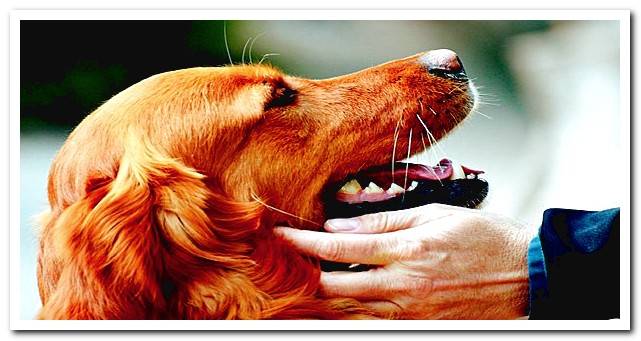
Possible diseases in Setter dogs
In general, English Setter are especially healthy and vital. They do not usually suffer from illnesses, so they are very long-lived. Even so, among the most common diseases that this breed can suffer we find the following.
- INJURIES IN THE CARPUS: Being a hunting dog, it tends to be very temperamental and inexhaustible. That is why inflammatory processes occur in the carpus (our wrist joint).
- HIP DYSPLASIA: Although it is not very frequent, from time to time this problem appears. It is a genetic disease in which several genes from both parents are involved. It affects the ligaments by means of which the articulation of the femur with the hip is held, reason why they become more lax.
The joint gains slack and the bones, instead of moving smoothly, collide and become damaged, appearing the symptoms of premature osteoarthritis.
Currently there is no effective treatment to avoid this disease, so to avoid it, it would be important to focus on good genetic selection. - OTITIS: It is the most frequent problem in Setters in general. This breed has all the conditions to suffer them. Having long ears and abundant fur is an impediment to proper ventilation of the ear canal. In addition, we must add the summer spikes that enter the ear during a hunting day and what this breed likes water. In short, all the ingredients for an annoying otitis to appear.It is very important to periodically trim the hair on the inside of the ear.
- TAIL BREAK: Because the Setters tend to constantly move the tail, it ends up being damaged by the vegetation and it may even break a coccygeal vertebra. This condition is very common in very nervous and active dogs locked in very small kennel cages.
- GASTRIC TORSION: It is actually a disease common to all dogs, but its appearance in dogs with a larger size and great physical activity is special. A turn occurs in the intestine and a subsequent collapse of the blood supply. It is essential to know the gastric torsion symptoms to detect it in time and know how to act.
Food and care in all types of Setter
The ideal amount of kcal for this breed ranges from 1,500 to 1,700 daily. If the specimen is subjected to intense physical activity, the quantities should be increased.
Although this breed easily adapts to family life in an apartment, it needs large doses of daily exercise.
As for hair, it is recommended to brush 2-3 times a week to avoid knots and keep it healthy and shiny, as well as healthy skin.
Finally, add that all types of Setter, due to their high rate of physical activity, have a higher risk of suffering heat stroke. Due to the passion with which they live hunting, sometimes they do not know when to stop and, when they do, it is too late.
